“Fire has helped the flammable spinifex invade this vast land, and that spinifex has helped fire to dominate the landscape”. Peter Latz
So I’ll see you out on the mulga and spinifex plain; Anytime, Tjilpi, I’ll be coming back this way; See you out on the mulga and spinifex plain; Just light me a fire and I’ll soon be home again
“Mulga and spinifex plain”, Warumpi Band (Track 10 on Big Name, No Blankets)
As we have travelled through large arid and semi-arid areas of Australia, two vegetation communities have dominated the country – spinifex grasslands and mulga shrublands. Their distribution is closely tied to Aboriginal use of the land and fire over millennia. Mulga’s dominance and conspicuous landscape presence have given rise to terms such as ‘mulga country’ or ‘mulga lands’. These areas are part of the less intensively grazed shrublands and grasslands of Australia’s arid and semi-arid regions.
Spinifex
Spinifex is the name given to many prickly hummocky types of grass found throughout arid and semi-arid regions. They are also known as porcupine or hummock grasses. Unique to Australia, these perennial grasses are essential to the diverse fauna of the outback. They are estimated to cover 27 per cent of the continent. The tightly rolled and sharp-tipped leaves are well-suited leaves to low rainfall and drought. They can survive in a state of dormancy until more favourable conditions return.
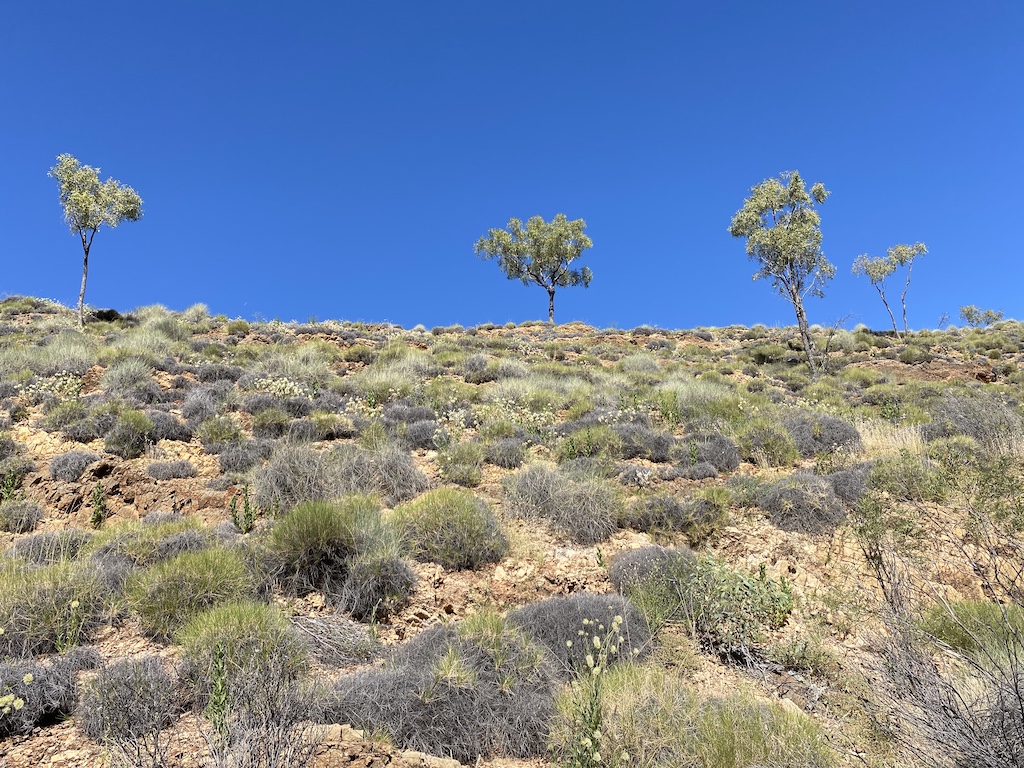
There are two loose groups of spinifex based on their different growth forms and distribution. The ‘hard’ species have closely packed, rigid leaves with sharp pointy ends which are almost impossible to touch. They form the more distinct rounded hummock habit and are the more widespread of the spinifexes. The ‘soft’ species have more loosely arranged, less rigid leaves and can be comparatively more easily handled. They tend to be more common in the northern half of the continent, forming a more continuous cover. The other difference between the two relates to their ability to produce resin. The cells that cover the leaves of soft species contains specialised resin producing cells, while hard spinifex does not contain these cells.
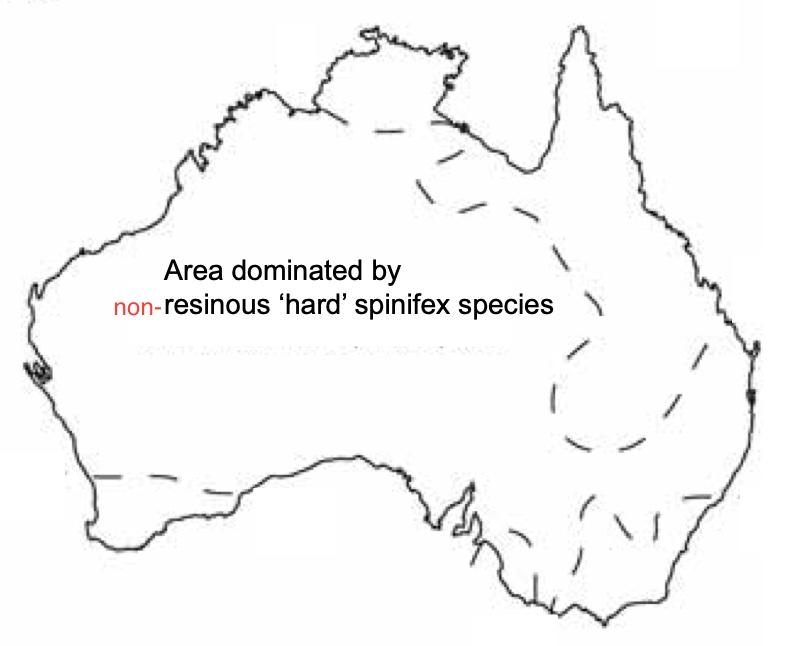
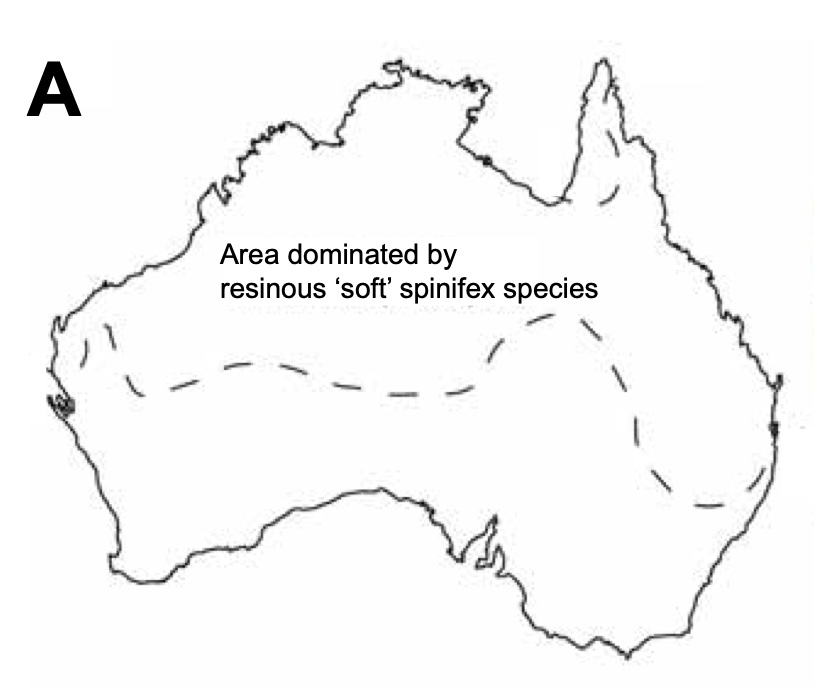
The non-resinous hard spinifex species start out growing in a neat little hummock in a circular ring with a hole in the middle. Spinifex seeds won’t germinate in the centre, and they die back in the middle of the hummock, and the outward growth carries on. Only seeds that fall outside the ring will grow. In this way, the rings get bigger and bigger. After some time, a new plant may germinate in the centre of the ring, and the process starts again.
The reason for the hole has been a mystery for some time. Scientists from the University of NSW believe it may be caused by microbes. International scientists thought that the circular gap patterning was in response to hot arid conditions. Clay-rich crusts develop in the topsoil, causing rain to shed across the surface, and spinifex responded by circling the crusts to share the infiltration in the sandier soils at their edges. However, more recent work by CSIRO ecologist, Dr Fiona Walsh, has convinced her the phenomenon is associated with termites. The theory is that termites make flat-surfaced concrete pavements that limit seed germination and plant growth, leading to bareness. Local Aboriginal elders have concurred in their own way, describing hard ground associated with termites. Beneath the hard surface are termite ‘towns’ – chambers and tunnels, including food stores and different caste of termites. Because they are clear of the needle-sharp spinifex, Aborigines sat comfortably on them and could walk across the spinifex grasslands when travelling through the desert.
There are some thirty different spinifex species around the country. When I drove through the Pilbara, I saw magnificent vistas of red rock combined with extensive areas of spinifex. These broad plains looked like sown cereal crops as hundreds of spinifex plants gently swayed together in the morning breeze. Their golden stems containing seeds rose well over a metre and glistened as the morning sun poked its head up over the horizon. The appearance of a spinifex landscape after a wildfire is like chalk and cheese – it loses all its beauty and can be almost reduced to ashes. However, as it begins to recover, the new spinifex growth can look like perfectly manicured hedges that you’d expect to find in an English garden designed by Lancelot ‘Capability’ Brown.
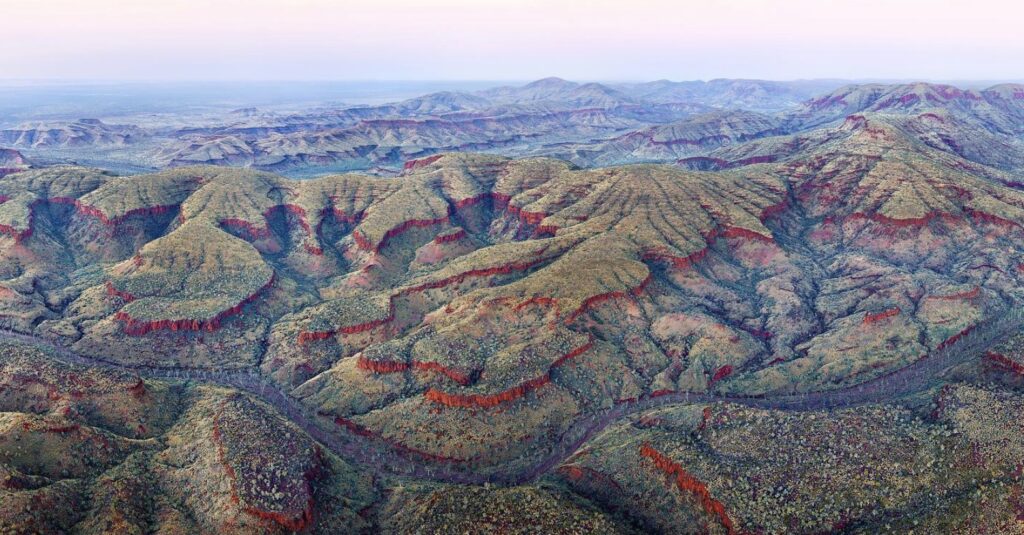
Mulga
On the other hand, mulga is an acacia that is perfectly adapted to hot and arid conditions. It has a sophisticated arrangement of phyllodes (a distinct morphological feature of acacias whose blade is much reduced or absent and takes on the functions of a whole leaf) and branches which slope upwards and channel rainwater to the stem and onto the ground, feeding its root system. While mulga starts with a taproot, it does get rid of it quite quickly and goes to a mass of small fibrous roots mostly within the drip area to benefit from light rainfall. Unlike other acacias, which are relatively short-lived, mulga has a life span of over 50 years. It is predominantly found on plains and sand plains of red earth soil adjacent to mountains and hills.
Mulga occupies about 20 per cent of arid and semi-arid Australia occurring in all mainland states. It dominates the rangelands where it occurs. Mulga species are extremely variable. Their taxonomic boundaries are poorly understood and identification of the different types within the complex can be difficult. For example, mulga comprises ten species with one, Acacia aneura, containing ten varieties. Numerous mulga hybrids also exists that adds substantially to these numbers.
Mulga grows on infertile soils, characterised by their strongly acid profile and low nutrient availability and surface sealing which contributes to significant rainfall runoff. This favours woody plant domination, such as mulga. Grasses can maintain their presence under the mulga through a combination of factors such as low grazing pressure, fuel accumulation and frequent low-intensity fires.
Mulga manages to survive and flourish in the dry interior. They drop many of their phyllodes during very dry spells to reduce the water demand and pull back as much nutrient as possible. They also fix nitrogen for their own needs in impoverished soils. As mulga expert, Ian Beale says, “when it comes to moisture and nutrients mulga is an ultimate anti-socialist!”
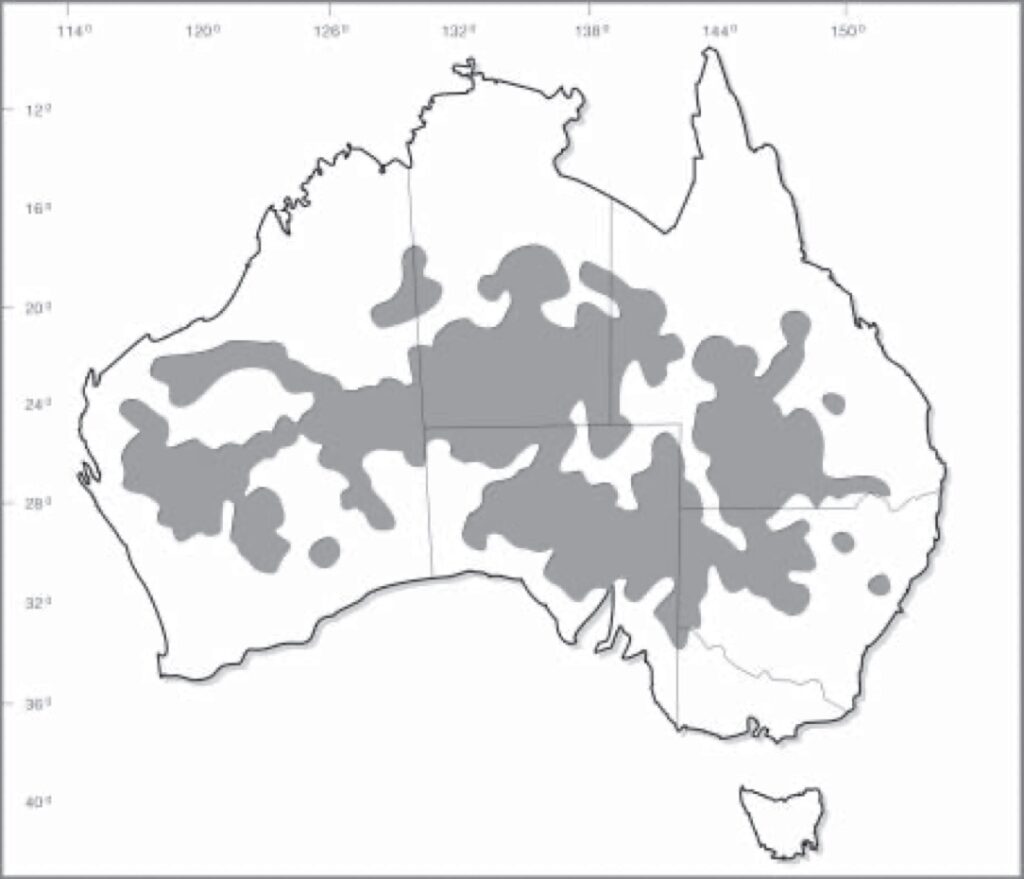
The role of fire
When Aborigines colonised Australia, they learnt to use fire to maximise food production. They burnt as they travelled through the country, controlled fuel build-up, and reduced the incidence of large, intense fires. This led to a mosaic of vegetation in different stages of recovery from fire, and provided a range of food sources for the Aborigines and the animals they hunted. A range of niches for plants and animals thrived. Mature patches persisted in dry times, and recently burnt patches could respond rapidly to minor rainfall events.
Spinifex communities are particularly well adapted to fires. Although most species are killed by fire, they can regenerate from seed after the first adequate rainfall, and some species are known to resprout from the rootstock. This allows spinifex to rapidly colonise sites that are burnt. Spinifex flourishes in areas with poor or shallow soils. Across the landscape, you can see distinct margins where rocky scree slopes are dominated by spinifex and below where red soil predominates, non-spinifex communities, such as mulga, dominate.
The exposure of the soil surface by frequent and intense fires can accelerate soil erosion and cause loss of nutrients when ash is carried away by wind or water. This makes the environment more conducive to the establishment of spinifex, which out competes species that previously occurred there. This is exacerbated by fires of a lesser frequency but of a higher intensity during summer.
Central Australian botanist, Peter Latz, has argued that fire and spinifex share a symbiotic relationship. Fire has helped the flammable spinifex invade large areas, while spinifex has allowed fire to dominate the landscape. Fires can race through spinifex country on a hot day in summer and penetrate shrublands killing the sensitive mulga. This is repeated as spinifex invades deeper into shrublands with more fires before shrubs can recover and seed. This alliance between hotter fire and spinifex is detrimental to the mulga shrublands.
Spinifex increases biomass and cover in proportion to cumulative rainfall since the last fire. It can persist during dry periods of below-average rainfall and increase growth rates in response to above-average rainfall amounts. They are long-lived perennials and keep accumulating biomass over several decades, increasing fire intensity when fire occurs. There is also an increase in connectivity of fuels which aids in fire spreading across the landscape.
Mulga’s relationship with fire, on the other hand, is a bit more complex. Mulga is considered to be a fire sensitive species. Yet, mulga is known to germinate prolifically after low-intensity fires and favourable conditions. Mulga regenerates from seed and has a variable capacity to resprout. Ian Beale says he has seen some stumps produce a few small suckers after the tree has been broken off but has never seen them survive, unlike other acacias. It has been argued that its ability to dominate other woody species is due to an ‘artificial subclimax’ caused by repeated fires. Mulga is believed to have only appeared as a dominant part of the landscape in the last 13,000 years associated with persistent indigenous burning practices.
Spinifex and mulga share common boundaries in arid and semi-arid country. This association is intriguing because spinifex loves all sorts of fires, but mulga is a bit more discerning. Severe and frequent hot wildfires kill it. A reduction in traditional burning has changed the fire regime in Central Australian rangelands from many small fires in various seasons to infrequent extensive summer fires. Large wildfires occurred in the 1920s, 1950s, mid-1970s, 2001-02 and 2011. Using satellite imagery, fire scientist Grant Allen calculated that the area of Central Australia that burned in 2001-02 was bigger than Italy and one and a half times the size of Victoria. These periods occurred in years following above-average rainfall and had a significant impact on the mulga country. Aborigines protected mulga from fire intensities and frequencies beyond its tolerance.
I mentioned earlier the term ‘artificial subclimax’. What this means is that a vegetation community develops short of maturity because of some factor or disturbance. In the case of mulga, the persistence of frequent low intensity fires within the tolerance of mulga allowed the species to dominate. Mulga has grown into the large trees we now see scattered across the rangelands because of the lack of regular fires. Mulga country is now being classed as woodlands instead of scrublands.
Management issues in mulga lands
Pastoralists trying to make a living in mulga country rely heavily on grass and small shrubs to feed their stock. In a young mulga community, pastures can grow within mulga lands along with perennial shrubs and various annual species, depending on the season. Mulga is a valuable forage supplement for livestock during droughts. This is because mulga retains its nutritional value in dry periods. Farmers lop branches or push trees over to allow stock access to the phyllodes. When conditions improve, there is usually a good pasture and regeneration response in areas where the mulga trees have been cut or pushed over.
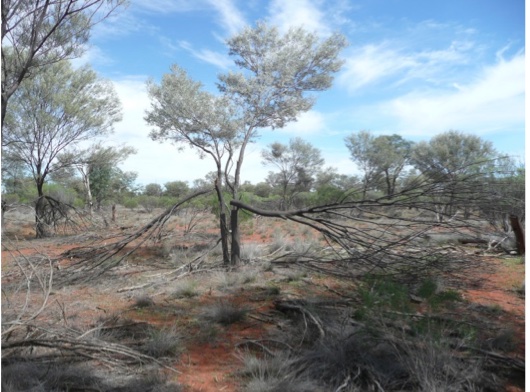
Before European settlement, most of the mulga country was open savannah, although caution is required when over-generalising. Ian Beale, told me about the difficulties William Landsborough had navigating the mulga scrub between Charleville and Cunnamulla when he was looking for Bourke and Wills. It is more likely that the landscape was transient with areas opened up by the fire-stick and others allowed to thicken.
Thickening across the broad mulga landscape dates back to the early decades of the last century. Historical perspectives are provided in the Inquiry into the Condition of Crown Tenants in the Western Division of NSW (Royal Commission 1901), “A Million Wild Acres” by Eric Rolls, and “The Delicate and Noxious Scrub” by Ian Noble. Jim Gasteen’s father took up a soldier settlement block in the Bollon district of Western Queensland at the end of WW1. The ensuing decades were very dry and according to Gasteen, “drought followed drought and in the absence of competition from ground layer species and a lack of fires because there was nothing to burn, inedible shrubs, mulga, cypress pine and eucalypt seedlings began to colonise the bare, open spaces”.
By the time mulga had matured into trees, the grass had disappeared, making it less attractive for grazing. The dominance of woody plants over grasses limits the options available to manage the problem. Grass growth is at a disadvantage compared to woody plants. This is because the initial advantage grasses have in the establishment phase, through faster growth and absorption of phosphorus, is quickly lost. Woody plants make more efficient use of the limited available nutrients through recycling mechanisms and their ability to develop a much larger root system. Monitoring of the increase of woody plant density in mulga lands is well documented. In one permanent transect, the density of mulga increased by 120 per cent in five years.
Ian Beale was a pasture research officer at the Charleville Patrol Laboratory for 33 years. He reminded me of the mulga clearing study and thinning trial that was set up in 1963 on Boatman Station about 100 kilometres south of Morven. At the start of the trial, the site was carrying 5,570 mulga trees per hectare. Former Queensland Government botanist Selwyn Everist worked as a meteorologist at Charleville for his WWII service and used this time to “develop his encyclopaedic knowledge of mulga”. He told Ian that the trial site was the original horse paddock for the station and was an open savanna in the early 1940s. Over the space of only 20 odd years, the area witnessed as an explosion of mulga. Ian and his colleagues had to thin the mulga to 640 trees per hectare before they got any pasture response.
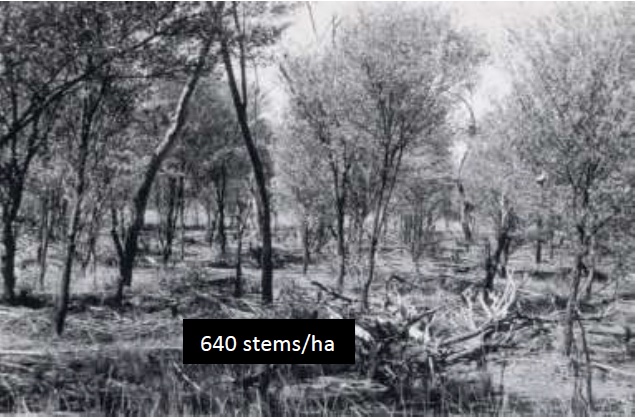
Ian believes the big increases in mulga density was related to the big wet of the early 1950s and it has been suggested that a swing to more cattle during the 1940s had a bearing on this change. Young mulga has high tannin levels so is less preferred by the cattle and it can be kept cropped within browsing height. But, as Everist observed, mulga growth rates can be from very minimal per year to about 3 feet in suitable seasons, and that is sufficient to take it beyond browsing control.
Pastoralists have dealt with the issue of exploding woody plant growth by clearing the older mulga to restore the balance between grass and trees. However, this has become difficult as a new narrative on land management has been captured by those not directly familiar with these arid and semi-arid lands and their history, and have supported bans on tree clearing across the whole landscape.
There are other options, but fire isn’t favoured in a grazed environment where fuel levels are insufficient to carry fire of enough intensity to control the woody species, unless the farmer is prepared to think and act opportunistically during a very small window. Many people don’t understand the main reason for this. On a per plant basis, grazing pressure in the mulga rangelands can be the same at the end of a drought as the beginning of it. Stock numbers are not subjected to wide variations expected in other arid and semi-arid environments due to recurring drought, mainly because of the presence of edible shrubs and trees and the underlying artesian basin. Therefore, grass recovery can be severely hampered by grazing pressures when they are least resistant to grazing.
Fuel build-up could be promoted by fencing off areas but believe it or not, this process is limited by grass harvesting termites which can remove more than 100 kilograms per hectare per year, particularly in the tropical rangelands! Another option is chemical control, but this is cost prohibitive. Finally, there is biological control through insect predators, but that is a long-term proposition that relies on a willing government to research and fund, not to mention the risks to non-target plants. One of the biggest constraints to any control program has been the scarcity of information on follow up measures for treated areas.
One controversial practice has been the clearing of acacia shrublands, followed by the introduction of buffel grass. This has been successful in gidgee scrublands but attempts at similar conversions in mulga lands have failed, and this has been attributed to the very low available phosphorus in the soils. Buffel grass need available phosphorus levels of more than 25 parts per million to establish successfully.
Simply reserving mulga communities and protecting or saving them by benign neglect and removing any form of human disturbance only creates an artificial wilderness and is detrimental to the environment.
What is the desired state of the spinifex-mulga lands?
The patterns of mulga increases are part of a cycle that needs to be managed. Around Charleville, the feed to feed cycle is about 20-25 years. From a grazier and land productivity point of view, the clearing of mulga leads to the replacement with grass and a new generation of trees. The young mulga provides fodder along with the grass for many years. If the mulga is allowed to mature, the grass and low shrubs are eliminated, becoming a monoculture. If the cycle is allowed to be repeated, then the diversity of the area is enhanced. The alternative view is that clearing should be banned, and the mulga and other woody plants left to dominate at the expense of other vegetation, thus reducing the biodiversity dramatically. Also, there are environmental impacts and soil erosion on the areas without any ground cover.
The intervention of government regulations on property management is flawed simply because they have no vested interest in keeping the mulga lands viable. From my point of view, I think it is essential that in realistic terms, the best way to manage these areas, post-Aboriginal influence, is to maintain mechanical intervention through pulling mulga trees and stock and grazing management. Then re-introduce fire management when the opportunity presents itself. The cycle of no fuel, no fire has to be broken.
The boundary between spinifex and mulga was created and maintained by fire. While both vegetation types can persist on the same soil types, it is a fire-driven soil gradient, and the effects of few, larger summer fires or no fires at all is detrimental for mulga. Thus, the delicate balance between the two communities has been broken in favour of spinifex. Where mulga still persists, it increasingly does so in an artificial form aided by government regulations.
Is that a good thing, and should we let it flourish, or should we acknowledge the fine mosaic is unstable and work with pastoralists to put in place active measures to try and restore some semblance to the past in the mulga lands?
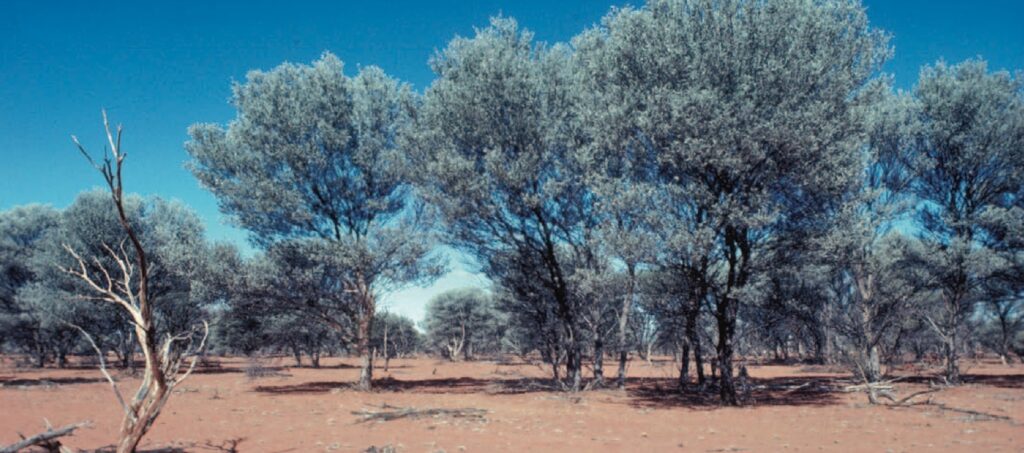
Great Information Robert, thanks.
My family have been in the Eulo district since the mid 1880’s. We have only survived because of the mulga tree.
Our family started with axes, then early 70’s my father brother and I started cutting scrub with chainsaws, it has since grown 50 times thicker, some arears so thick that you could not get it on the ground with a chainsaw. No grass or shrubs underneath.
In 1990 we bought a first bulldozer D4D since then 3 old D7’s and a chain, very rearly use the chain. I now have some of the best Mulga to grass ratio in the district, 30 different grasses edable shrubs and copper burrs. The Eulo air strip has been fenced for 60 years it can no longer grow anything but mulga.
In Qld coastal hardwood forests, the leaves of some Ironbark species are said to produce a toxic resin which leaches down into the soil and inhibits the germination of seeds under the canopy of the tree, thus limiting competition.
Perhaps the same thing is happening with the species of spinifex grass which you say also produces a resin. In an older clump, the resin may accumulate and kill the centre of the tuft. As the dead centre gets wider, there is less resin deposited, so eventually seeds are able to germinate there once again.
You have a romantic attitude to fire through saying it has a ‘symbiotic’ association with Spinifex. I can’t see that connection, because I think only living things can form a symbiotic relationship. Fire has no senses, so could not evolve to benefit from the spread of grass. Only the frequency and intensity of fires can alter the fate of the grass – not the other way around.
Interesting thought process nevertheless,
Alan